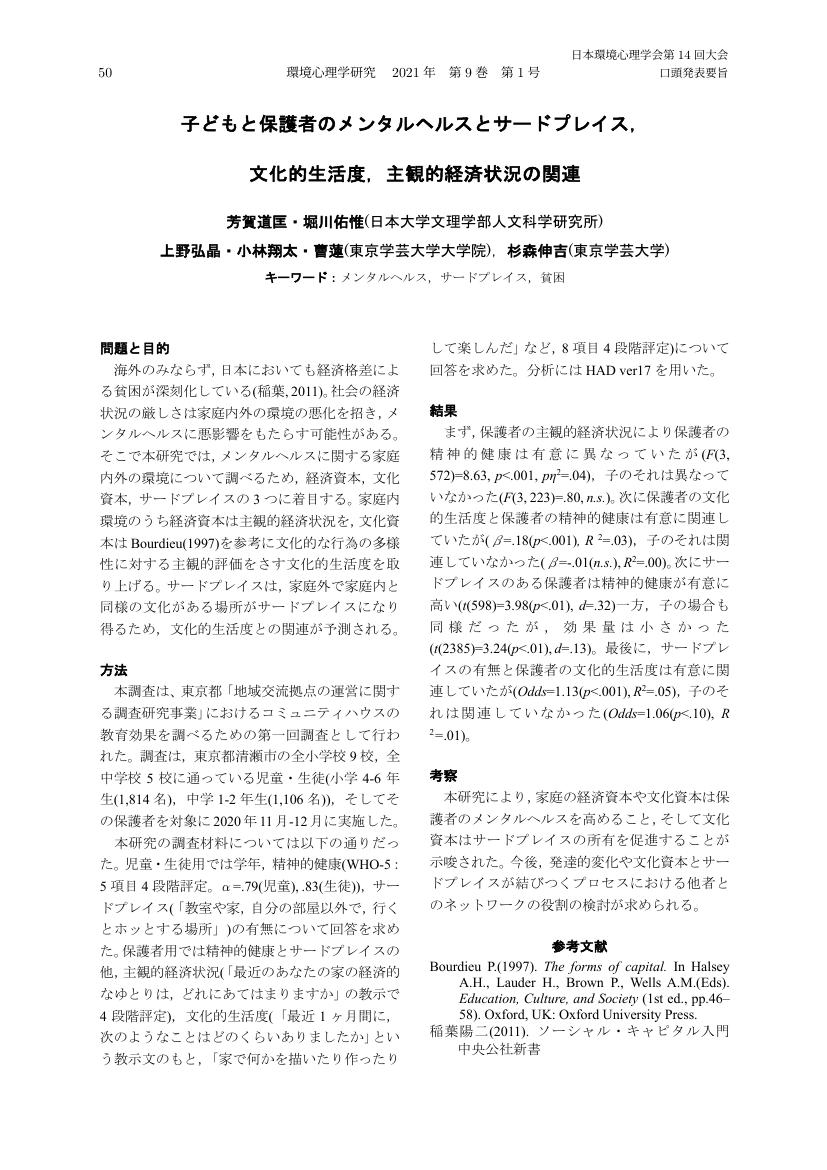10 0 0 0 OA 表情による感情認知における中国人と日本人の文化比較
- 著者
- 曹 蓮 杉森 伸吉 高 史明
- 出版者
- 公益社団法人 日本心理学会
- 雑誌
- 心理学研究 (ISSN:00215236)
- 巻号頁・発行日
- pp.91.18051, (Released:2020-09-15)
- 参考文献数
- 41
- 被引用文献数
- 1
In this research, we investigated cultural differences between Chinese and Japanese participants concerning perceptions of emotions by facial expressions (about specific feelings and to what extent those feelings can be experienced). We used gradual morphing images that express countenances from neutral facial expressions to anger or joy as stimuli. By doing this, participants identified emotion types and evaluated emotional strength. As a result, Japanese participants evaluated the emotional strength for moderate to distinct expressions of anger to a greater extent than Chinese participants. From this, we suggest that compared with the Chinese, the Japanese have a tendency to infer stronger internal anger (i.e, “augment”) than what is actually expressed.
5 0 0 0 OA 中国人と日本人の感情認知における表情と声の相互干渉性
- 著者
- 曹 蓮 杉森 伸吉 高 史明
- 出版者
- 公益社団法人 日本心理学会
- 雑誌
- 心理学研究 (ISSN:00215236)
- 巻号頁・発行日
- pp.88.15032, (Released:2017-01-14)
- 参考文献数
- 29
- 被引用文献数
- 1
In this study, we investigated cultural differences in multisensory perception of emotion between Chinese and Japanese participants, focusing on mutual interference of visual and auditory emotional information. In this experiment, the face-voice pairs were consisted of congruent or incongruent emotions (e.g., a happy (an angry) face with a happy (an angry) voice in congruent pairs, and a happy (an angry) face with an angry (a happy) voice in incongruent pairs). Participants were asked to judge the emotion of targets focusing on either face or voice while ignoring the other modality’s information. In the voice-focus condition, the effect of to-be-ignored facial information was smaller in Japanese than Chinese participants, only when the participant and the target belonged to the same cultures (in-group). This indicated that Japanese people were more likely to be based on the voice information in multisensory perception of emotion of in-group. Our study illuminated that although both Japanese and Chinese people belonged to the Eastern culture, there were cultural differences in perceiving emotion from visual and auditory cues.
2 0 0 0 OA 中国人と日本人の感情認知における表情と声の相互干渉性
- 著者
- 曹 蓮 杉森 伸吉 高 史明
- 出版者
- 公益社団法人 日本心理学会
- 雑誌
- 心理学研究 (ISSN:00215236)
- 巻号頁・発行日
- vol.88, no.1, pp.1-10, 2017 (Released:2017-04-25)
- 参考文献数
- 29
- 被引用文献数
- 1 1
In this study, we investigated cultural differences in multisensory perception of emotion between Chinese and Japanese participants, focusing on mutual interference of visual and auditory emotional information. In this experiment, the face-voice pairs were consisted of congruent or incongruent emotions (e.g., a happy (an angry) face with a happy (an angry) voice in congruent pairs, and a happy (an angry) face with an angry (a happy) voice in incongruent pairs). Participants were asked to judge the emotion of targets focusing on either face or voice while ignoring the other modality’s information. In the voice-focus condition, the effect of to-be-ignored facial information was smaller in Japanese than Chinese participants, only when the participant and the target belonged to the same cultures (in-group). This indicated that Japanese people were more likely to be based on the voice information in multisensory perception of emotion of in-group. Our study illuminated that although both Japanese and Chinese people belonged to the Eastern culture, there were cultural differences in perceiving emotion from visual and auditory cues.
2 0 0 0 中国人と日本人の感情認知における表情と声の相互干渉性
<p>In this study, we investigated cultural differences in multisensory perception of emotion between Chinese and Japanese participants, focusing on mutual interference of visual and auditory emotional information. In this experiment, the face-voice pairs were consisted of congruent or incongruent emotions (e.g., a happy (an angry) face with a happy (an angry) voice in congruent pairs, and a happy (an angry) face with an angry (a happy) voice in incongruent pairs). Participants were asked to judge the emotion of targets focusing on either face or voice while ignoring the other modality's information. In the voice-focus condition, the effect of to-be-ignored facial information was smaller in Japanese than Chinese participants, only when the participant and the target belonged to the same cultures (in-group). This indicated that Japanese people were more likely to be based on the voice information in multisensory perception of emotion of in-group. Our study illuminated that although both Japanese and Chinese people belonged to the Eastern culture, there were cultural differences in perceiving emotion from visual and auditory cues.</p>
